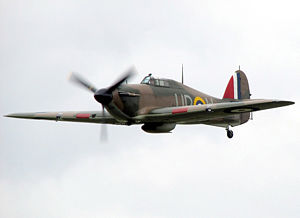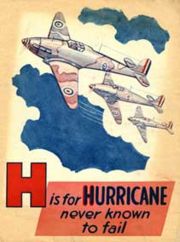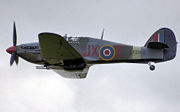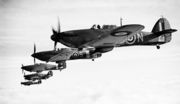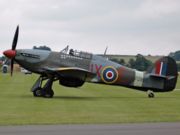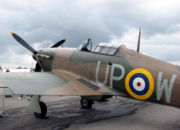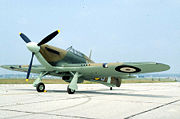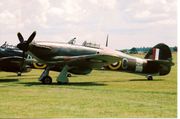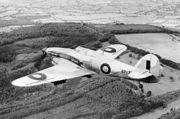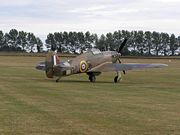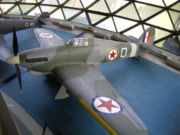Hawker Hurricane
2008/9 Schools Wikipedia Selection. Related subjects: Air & Sea transport
| Hurricane | |
|---|---|
|
Hurricane I (R4118), a Hurricane from the 1940 Battle of Britain still flying (as of 2007). |
|
| Type | Fighter |
| Manufacturer | Hawker |
| Designed by | Sydney Camm |
| Maiden flight | 6 November 1935 |
| Introduced | 1937 |
| Primary user | Royal Air Force |
| Produced | 1937- 1944 |
| Number built | 14,000 |
The Hawker Hurricane was a British single-seat fighter aircraft designed and predominantly built by Hawker Aircraft Ltd. Some production of the Hurricane was carried out in Canada by the Canada Car and Foundry Co Ltd.
The 1930s design evolved through several versions and adaptations, resulting in a series of aircraft which acted as interceptor-fighters, fighter-bombers (also called "Hurribombers"), and ground support aircraft. Further versions known as the Sea Hurricane had modifications which enabled operation from ships. The Hurricane was significant in enabling the Royal Air Force (RAF) to win the Battle of Britain of 1940, accounting for the majority of the RAF's air victories. About 14,000 Hurricanes were built by the end of 1944 (including about 1,200 converted to Sea Hurricanes, and about 1,400 that were built in Canada), and served in all the major theatres of the Second World War.
Design and development
The Hurricane was developed by Hawker Aircraft Ltd in response to the Air Ministry specification F.36/34, (modified by F.5/34) for a fighter aircraft built around the new Rolls-Royce engine, then only known as PV-12, later to become famous as the Merlin. At that time, RAF Fighter Command comprised just 13 squadrons, each equipped with either Hawker Furys, Hawker Hart variants, or Bristol Bulldogs – all biplanes with fixed- pitch wooden propellers and non-retractable undercarriages. The design, started in early 1934, was the work of Sydney Camm.
Sydney Camm's original plans submitted in response to the Air Ministry's specification were rejected (apparently "too orthodox," even for the Air Ministry). Camm tore up the proposal and set about designing a fighter as a Hawker company private venture. With economy in mind, the Hurricane was designed using as many of Hawker's existing tools and jigs as possible (the aircraft was effectively a monoplane version of the successful Hawker Fury); and it was these factors that were major contributors to the aircraft's success.
Early design stages of the "Fury Monoplane" incorporated a Rolls-Royce Goshawk engine, but this was replaced shortly after with the Merlin, and featured a retractable undercarriage. The design came to be known as the "Interceptor Monoplane," and by May 1934, the plans had been completed in detail. To test the new design, a one-tenth scale model of the aircraft was made and sent to the National Physical Laboratory at Teddington. A series of wind tunnel tests confirmed the vital basic aerodynamic qualities of the design were in order, and by December that year, a full size wooden mock-up of the aircraft had been created.
The first prototype, K5083, began construction in August 1935 incorporating the PV-12 Merlin engine. The completed sections of the aircraft were taken to the Brooklands racing circuit where Hawkers had an assembly shed, and re-assembled on 23 October 1935. Ground testing and taxi trials took place over the following two weeks, and on 6 November 1935, the prototype took to the air for the first time at the hands of Hawker's chief test pilot, Flight Lieutenant (later Group Captain) P.W.S. Bulman. Flight Lieutenant Bulman was assisted by two other pilots in subsequent flight testing; Philip Lucas flew some of the experimental test flights, while John Hindmarsh conducted the firm's production flight trials.
Even though faster and more advanced than the RAF's current frontline biplane fighters, the Hurricane's design was already outdated when introduced. It employed traditional Hawker construction techniques from previous biplane aircraft, with mechanically fastened, rather than welded joints. It had a Warren girder-type fuselage of high-tensile steel tubes, over which sat frames and longerons that carried the doped linen fabric covering. The Hurricane's traditional construction meant that the airframe was very durable, and proved far more resistant to exploding cannon shells than the metal-skinned Supermarine Spitfire. Initially, the wing structure consisted of two steel spars, and was also fabric-covered. An all-metal, stressed-skin wing of duraluminium (a DERD specification similar to AA2024) was introduced in April 1939 and was used for all of the later marks. In contrast, the contemporary Spitfire used all-metal monocoque construction and was thus both lighter and stronger, though less tolerant to bullet damage. With its ease of maintenance, widely set landing gear and benign flying characteristics, the Hurricane remained in use in theatres of operations where reliability, easy handling and a stable gun platform were more important than performance, typically in roles like ground attack.
In March 1940, Hurricanes with the Merlin II and III engines began to receive modifications to allow for an additional 6lbs of supercharger boost, for several minutes, (although, there are accounts of its use for 30 minutes continuously). This modification gave the Hurricane an approximate increase in speed of 25 to 35mph, under 15,000ft altitude, and greatly increased the aircraft's climb rate. "Overboost" or "pulling the plug" was an important wartime modification, that allowed the Hurricane to remain competitive with the Me-109e and to increase its margin of superiority over the Me110c, especially at low altitude. Overboost increased engine output by nearly 250hp. The Supermarine Spitfire also benefited greatly when using overboost.
Production
The Hurricane was ordered into production in June 1936, mainly due to its relatively simple construction and ease of manufacture. As the prospect of war was looking increasingly likely, and time was of the essence in providing the RAF with an effective fighter aircraft, it was unclear if the more advanced Spitfire would be able to enter production smoothly, while the Hurricane used well-understood manufacturing techniques. This was true for service squadrons as well, who were experienced in working on and repairing aircraft whose construction employed the same principles as the Hurricane, and the simplicity of its design enabled the improvisation of some remarkable repairs in Squadron workshops.
Powered by a Merlin II engine, the maiden flight of the first production aircraft took place on 12 October 1937. The first four aircraft to enter service with the RAF joined 111 Squadron at RAF Northolt the following December, and by the outbreak of the Second World War, nearly 500 Hurricanes had been produced, and equipped 18 squadrons.
In all, some 14,000 Hurricanes and Sea Hurricanes were produced. The majority of Hurricanes were built by Hawker (which produced them until 1944) with the Gloster Aircraft Company making most of the rest. The Austin Motor Company built 300. Canada Car and Foundry in Fort William, Ontario, Canada, (where the Chief Engineer, Elsie MacGill, became known as the "Queen of the Hurricanes") was responsible for production of 1,400 Hurricanes, known as the Mk X.
In 1939 production of 100 Hurricanes was initiated in Yugoslavia by Zmaj and Rogozarski. Of these 20 were built by Zmaj by April 1941. One was fitted with a DB 601 and testflown in 1941.
A contract for 80 Hurricanes was placed with Avions Fairey SA for the Belgian Air Force in 1938. Three were built and two flown by the time of the Blitzkrieg in May 1940.
Operational history
Battle of France
In response to a request from the French government for ten fighter squadrons to provide air support, Air Chief Marshal Sir Hugh Dowding, Commander-in-Chief of RAF Fighter Command, insisted that this number would deplete British defences severely, and so initially only four squadrons of Hurricanes, Nos. 1, 73, 85 and 87, were relocated to France, keeping Spitfires back for "Home" defence. The first to arrive was No.73 Squadron on 10 September 1939, followed shortly by the other three, and a little later Nos. 607 and 615 Squadrons joined them. In May the following year, Nos. 3, 79 and 504 Squadrons reinforced them as Germany's Blitzkrieg gathered momentum, and on 13 May 1940, a further 32 Hurricanes arrived. All ten requested Hurricane squadrons were then operating from French soil and felt the full force of the Nazi offensive. By 17 May, the end of the first week of fighting, only three of the squadrons were near operational strength, but despite their heavy losses the Hurricanes had managed to destroy nearly double the number of German aircraft.
Flying Officer E.J."Cobber" Kain was responsible for No. 73 Squadron's first victory in October 1939, while stationed in France, subsequently he went on to be the RAF's first fighter ace of the war. In June 1940, prior to heading for England at the start of his leave, on leaving his airfield, he crashed during a low-level "victory roll" and lost his life.
On 27 May 1940, 13 aircraft from No. 501 Squadron intercepted 24 Heinkel He 111s escorted by 20 Messerschmitt Bf 110s, and during the ensuing battle, 11 Heinkels were confirmed "kills" and others damaged, with little damage to the Hurricanes.
Battle of Britain
At the end of June 1940, following the fall of France, the majority of the RAF's 36 fighter squadrons were equipped with Hurricanes. The Battle of Britain officially lasted from 10 July until 31 October 1940, but the heaviest fighting took place between 8 August and 21 September 1940. Both Spitfires and Hurricanes are renowned for their part in defending Britain against the Luftwaffe's might – generally the Spitfire would intercept the German fighters leaving Hurricanes to concentrate on destroying the bombers, but despite the undoubted abilities of the "thoroughbred" Spitfire, it was the "workhorse" Hurricane that scored the highest number of RAF victories during this period, accounting for 1,593 out of the 2,739 total claimed.
The only Battle of Britain Victoria Cross was awarded to Flight Lieutenant Eric Nicolson, as a result of an action on 16 August 1940 when his section of three Hurricanes was "bounced" from above by Bf 110 fighters. All three were hit simultaneously. Nicolson was badly wounded, and his Hurricane was damaged and engulfed in flames. While attempting to leave the cockpit, Nicolson noticed that one of the Bf 110s had overshot his aircraft. He returned to the cockpit, which by now was a blazing inferno, engaged the enemy, and may have shot the Bf 110 down.
North Africa
The Hurricane II was hastily tropicalised following Italy's entry into the war in June 1940. These aircraft were initially ferried through France by air to No. 80 Squadron RAF, in Egypt, to replace Gladiators. The Hurricane claimed its first kill in the Mediterranean on 19 June 1940, when F/O P. G. Wykeham-Barnes reported shooting down two Fiat CR.42s.
Hurricanes served with several British Commonwealth squadrons in the Desert Air Force. They suffered heavy losses over North Africa after the arrival of Bf 109E and F-variants and were progressively replaced in the air superiority role from June 1941 by Curtiss Tomahawks/Kittyhawks. However, fighter-bomber variants ("Hurribombers") retained an edge in the ground attack role, due to their impressive armament of four 20 mm cannon and a 500 lb bombload.
During and following the five-day El Alamein artillery barrage that commenced on the night of 23 October 1942, six squadrons of Hurricanes claimed to have destroyed 39 tanks, 212 lorries and armoured troop-carriers, 26 bowsers, 42 guns, 200 various other vehicles and four small fuel and ammunition dumps, flying 842 sorties with the loss of 11 pilots. Whilst performing in a ground support role, Hurricanes based at RAF Castel Benito, Tripoli, knocked out six tanks, 13 armoured vehicles, ten lorries, five half-tracks, a gun and trailer, and a wireless van on 10 March 1943, with no losses to themselves.
Defence of Malta
The Hurricane played a significant role in the defence of Malta. When Italy entered the war on 10 June 1940, Malta's air defence rested on a few Gloster Gladiators which managed to hold out against vastly superior numbers of the Italian air force during the following three weeks. Four Hurricanes joined them at the end of June, and together they faced attacks throughout July from the 200 enemy aircraft based in Sicily, with the loss of one Gladiator and one Hurricane. Further reinforcements arrived on 2 August in the form of 12 more Hurricanes and two Blackburn Skuas, which prompted the Italians to employ German Junkers Ju 87 dive bombers to try and destroy the airfields. Finally, in an attempt to overcome the stiff resistance put up by these few aircraft, the Luftwaffe took up base on the Sicilian airfields only to find that Malta was not an easy target. After numerous attacks on the island over the following months, and the arrival of an extra 23 Hurricanes at the end of April 1941, and a further delivery a month later, the Luftwaffe left Sicily for the Russian Front in June that year.
As Malta was strategically situated on the increasingly important sea supply route for the North African campaign, the Luftwaffe returned with a vengeance for a second assault on the island at the beginning of 1942. It wasn't until March, when the onslaught was at its highest, that 15 Spitfires flew in off the carrier HMS Eagle to join with the Hurricanes already stationed there and bolster the defence, but many of the new aircraft were lost on the ground and it was again the Hurricane that bore the brunt of the early fighting until further reinforcements arrived. In relation to this second intensive assault on Malta, Wing Commander P.B. "Laddie" Lucas is quoted as saying:
| “ | For weeks a handful of Hurricane IIs, aided by Group Captain A.B. Woodhall's masterly controlling, had been meeting, against all the odds, the rising crescendo of Field Marshal Kesselring's relentless attacks on Grand Harbour and the airfields. Outnumbered, usually, by 12 or 14 to one and, later – with the arrival of the Me 109Fs in Sicily – outperformed, the pilots of the few old aircraft which the ground crews struggled valiantly to keep serviceable, went on pressing their attacks, ploughing their way through the German fighter screens, and our flak, to close in with the Ju 87s and 88s as they dived for their targets. | ” |
|
—Wing Commander P.B. "Laddie" Lucas D.S.O., D.F.C. |
||
Air defence in Russia
Mk II Hurricanes played an important air defence role in 1941 when the Soviet Union found itself under threat from the German Army approaching on a broad front stretching from Leningrad, Moscow, and to the oil fields in the south. Britain's decision to aid the Soviets meant sending supplies by sea to the far northern ports, and as the convoys would need to sail within range of enemy air attack from the Luftwaffe based in neighbouring Finland, it was decided to deliver a number of Hurricane Mk IIBs, flying with Nos. 81 and 134 Squadrons, to provide protection. Twenty-four were transported on the carrier HMS Argus arriving just off Murmansk 28 August 1941, and another 15 crated aircraft on board merchant vessels. In addition to their convoy protection duties, the aircraft also acted as escorts to Russian bombers. Enemy attention to the area declined in October, at which point the RAF pilots trained their Soviet counterparts to operate the Hurricanes themselves and, by the end of the year, the RAF's role had ended, but the aircraft remained behind and became the first of thousands of Allied aircraft that would be accepted by the Soviet Union.
Singapore & Dutch East Indies
Following the outbreak of war with Japan, 51 Hurricanes (MkII) were sent in crates to Singapore, with 24 pilots, the nuclei of five squadrons. They arrived on 3 January, 1942, by which stage the Allied fighter squadrons in Singapore, flying Brewster Buffalos, had been overwhelmed in the Malayan campaign. The Imperial Japanese Army Air Force's fighter force, especially the Nakajima Ki-43, had been underestimated in capability, numbers and the strategy of its commanders.
The recently-arrived pilots were formed into No. 232 Squadron. In addition, No. 488 Squadron RNZAF, a Buffalo squadron, converted to Hurricanes. 232 Sqn became operational on 20 January and suffered the first losses and victories for the Hurricane in East Asia, when S/L Lawrence Landels was shot down and killed; he was avenged by his number two, Sgt Jimmy Parker. The squadron destroyed three Ki-43s that day, for the loss of three Hurricanes. However, like the Buffalos before them, the Hurricanes began to suffer severe losses in intense dogfights.
On 27- 30 January, another 48 Hurricanes (Mk IIA) arrived with No. 226 Group (four squadrons) on the aircraft carrier HMS Indomitable, from which they flew to airfields code-named P1 and P2, near Palembang, Sumatra in the Dutch East Indies.
Because of inadequate early warning systems, Japanese air raids were able to destroy 30 Hurricanes on the ground in Sumatra, most of them in one raid on 7 February. After Japanese landings in Singapore, on 10 February, the remnants of 232 and 488 Squadrons were withdrawn to Palembang. However, Japanese paratroopers began the invasion of Sumatra on 13 February. Hurricanes destroyed six Japanese transport ships on 14 February, but lost seven aircraft in the process. On 18 February, the remaining Allied aircraft and aircrews moved to Java. By this time, only 18 serviceable Hurricanes remained out of the original 99.
After Java was invaded, some of the pilots and a sole remaining Hurricane were evacuated by sea to Australia. One pilot, Sgt Jimmy King, claimed 6.5 aircraft destroyed during the campaign.
Burma
Hurricanes saw action the day they first arrived in Burma, on 23 January 1942, when aircraft hampered by fixed underwing fuel tanks, were forced to intercept a Japanese air raid.
Survivors
Shoreham Airshow crash
During the annual airshow at Shoreham Airport, Sussex, on 15 September 2007 Hurricane BD707 was involved in a fatal accident, the pilot Brian Brown being killed. The aircraft crashed during a mock dogfight and airfield attack sequence involving six Spitfires, three Hurricanes, two Me 108s and one Bf 109. Witnesses described how the aircraft had "turned quite steeply, went into almost a straight dive and ploughed into a hill probably about a mile from the airfield." The six Spitfires spontaneously adopted the " missing man formation" to signal the loss of a colleague. The show continued after discussions with the other pilots involved, and the organisers and safety team.
Variants
- Hurricane I
- First production version, with fabric-covered wings, a wooden two-bladed, fixed- pitch propeller, powered by the 1,030-hp (768-kW) Rolls-Royce Merlin Mk II or III engines and armed with eight .303-inch Browning machine guns. Produced between 1937 and 1939.
- Hurricane I (revised)
- A revised Hurricane I series built with a de Havilland or Rotol constant speed metal propeller, metal-covered wings, armour and other improvements. In 1939, the RAF had taken on about 500 of this later design to form the backbone of the fighter squadrons.
- Hurricane IIA Series 1
- Hurricane I powered by the improved Merlin XX engine. First flew on 11 June 1940 and went into squadron service in September 1940.
- Hurricane IIB (Hurricane IIA Series 2)
- Hurricane IIA Series 1 equipped with new and slightly longer propeller spinner and new wing mounting 12 .303-inch Browning machine guns. The first aircraft were built in October 1940 and were renamed Mark IIB in April 1941.
- Hurricane IIB Trop.
- For use in North Africa the Hawker Hurricane IIB (and other variants) were tropicalised. They were fitted with engine dust filters and the pilots were issued with a desert survival kit.
- Hurricane IIC (Hurricane IIA Series 2)
- Hurricane IIA Series 1 equipped with new and slightly longer propeller spinner and new wing mounting four 20-mm Hispano cannons. Hurricane IIA Series 2 became the Mark IIC in June 1941, using a slightly modified wing. The new wings also included a hardpoint for a 500 lb or 250 lb bomb, and later in 1941, fuel tanks. By then performance was inferior to the latest German fighters, and the Hurricane changed to the ground-attack role, sometimes referred to as the Hurribomber. The mark also served as a night fighter and "intruder."
- Hurricane IID
- Hurricane IIB conversion armed with two 40-mm AT cannons in a pod under each wing and a single Browning machine gun in each wing loaded with tracers for aiming purposes. The first aircraft flew on 18 September 1941, deliveries started in 1942. Serial built aircraft had additional armour for the pilot, radiator and engine, and were armed with a Rolls-Royce gun with 12 rounds, later changed to the Vickers S 40-mm gun with 15 rounds. The weight of guns and armour protection marginally impacted the aircraft's performance. These Hurricanes were nicknamed "Flying Can Openers", perhaps a play on the No. 6 Squadron's logo which flew the Hurricane starting in 1941.
- Hurricane IIE
- Another wing modification was introduced in the Mk IIE, but the changes became extensive enough that it was renamed the Mk IV after the first 250 had been delivered.
- Hurricane T.IIC
- Two-seat training version of the Mk. IIC. Only two aircraft were built for the Persian Air Force.
- Hurricane III
- Version of the Hurricane II powered by a Packard-built Merlin engine, intending to provide supplies of the British-built engines for other designs. By the time production was to have started, Merlin production had increased to the point where the idea was abandoned.
- Hurricane IV
- The last major change to the Hurricane was to "rationalise" the wing, configuring it with a single design able to mount two bombs, two 40-mm Vickers S guns, or eight "60 pounder" RP-3 rockets. The new design also incorporated the improved Merlin 24 or 27 engines of 1,620-hp (1,208-kW), equipped with dust filters for desert operations.
- Hurricane V
- Two Hurricane IVs were fitted with a Merlin 32 engine driving a four-bladed propeller for ground attack duties.
- Hurricane X
- Canadian-built variant. Single-seat fighter and fighter-bomber. Powered by a 1,300-hp (969-kW) Packard Merlin 28. Eight 0.303-inch (7.7-mm) machine guns mounted in the wings. In total, 490 were built.
- Hurricane XI
- Canadian-built variant. 150 were built.
- Hurricane XII
- Canadian-built variant. Single-seat fighter and fighter-bomber. Powered by a 1,300-hp (969-kW) Packard Merlin 29. Initially armed with 12 0.303-inch (7.7-mm) machine guns, but this was later changed to four 20-mm cannons.
- Hurricane XIIA
- Canadian-built variant. Single-seat fighter and fighter-bomber. Powered by a 1,300-hp (969-kW) Packard Merlin 29, armed with eight 0.303-inch (7.7-mm) machine guns.
- Sea Hurricane IA
- The Sea Hurricane IA was a Hurricane Mk I modified by General Aircraft Limited. They were modified to be carried by CAM ships ( catapult armed merchantman). These were cargo ships equipped with a catapult for launching an aircraft, but without facilities to recover them. Thus, if the aircraft were not in range of a land base, pilots were forced to bail out and be picked up by the ship. They were informally known as "Hurricats".
- The majority of the aircraft modified had suffered wear-and-tear from serving with front line squadrons, so much so that at least one example used during trials broke up under the stress of a catapult launching. A total of 50 aircraft were converted from Hurricane Mk Is.
- Sea Hurricane IB
- Hurricane IIA Series 2 version equipped with catapult spools plus an arrester hook. From October 1941, they were used on Merchant aircraft carrier (MAC ships), which were large cargo vessels with a flight deck enabling aircraft to be launched and recovered. A total of 340 aircraft were converted.
- Sea Hurricane IC
- Hurricane IIB and IIC version equipped with catapult spools, an arrester hook and the four-cannon wing. From February 1942, 400 aircraft were converted.
- Sea Hurricane IIC
- Hurricane IIC version equipped with naval radio gear; 400 aircraft were converted and used on fleet carriers.
- Sea Hurricane XIIA
- Canadian-built Hurricane XIIA converted into Sea Hurricanes.
Operators
The Hawker Hurricane, due to its rugged construction and ease of maintenance, enjoyed a long operational life in all theatres of war, flown by both the Axis and Allies. It served in the air forces of many countries, some "involuntarily" as in the case of Hurricanes which either landed accidentally or force-landed in neutral Ireland.
|
Specifications (Hurricane IIC)
Data from Jane’s Fighting Aircraft of World War II
General characteristics
- Crew: One
- Length: 32 ft 3 in (9.84 m)
- Wingspan: 40 ft 0 in (12.19 m)
- Height: 13 ft 1½ in (4.0 m)
- Wing area: 257.5 ft² (23.92 m²)
- Empty weight: 5,745 lb (2,605 kg)
- Loaded weight: 7,670 lb (3,480 kg)
- Max takeoff weight: 8,710 lb (3,950 kg)
- Powerplant: 1× Rolls-Royce Merlin XX liquid-cooled V-12, 1,185 hp at 21,000 ft (883 kW at 6,400 m)
Performance
- Maximum speed: 340 mph (547 km/h) at 21,000 ft (6,400 m) (320 mph (514 km/h) at 19,700 ft (6,004 m) with two 250 lb bombs)
- Range: 600 mi (965 km)
- Service ceiling 36,000 ft (10,970 m)
- Rate of climb: 2,780 ft/min (14.1 m/s)
- Wing loading: 29.8 lb/ft² (121.9 kg/m²)
- Power/mass: 6.47 lb/hp (3.94 kg/kW)
Armament
- Guns:
- IIa: 8× 0.303 in (7.7 mm) Browning machine guns
- IIb: 12× 0.303 in (7.7 mm) Browning machine guns
- IIc: 4× 20 mm Hispano Mk II cannon
- IId: 2× 40 mm Vickers Type S cannon, 2× 0.303 in (7.7 mm) Browning machine guns
- Bombs (Mk. IIb and later models):
- 2× 250 lb or 500 lb bombs
